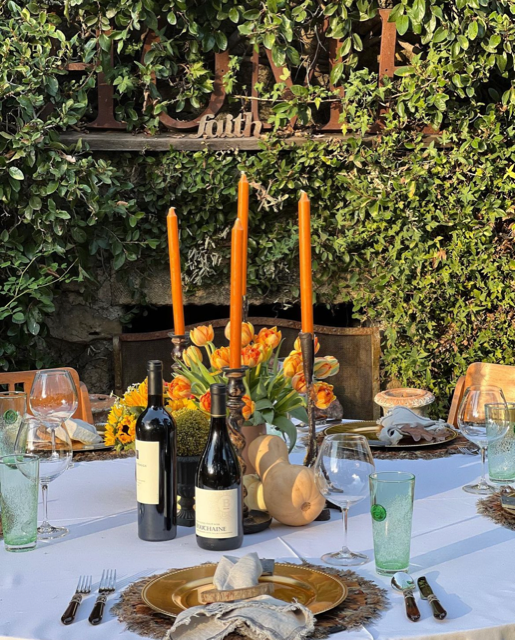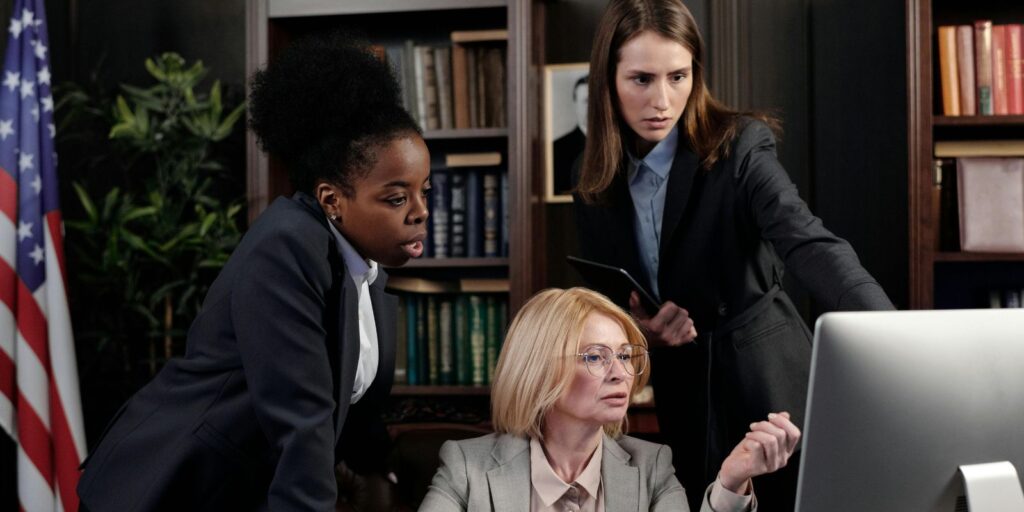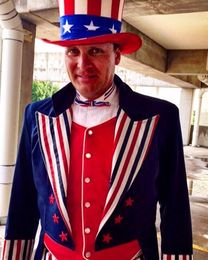
It wasn’t that long ago when we were contemplating turkey and pumpkin pie in terms of social distance and vaccination status. As we hurtle toward the holiday season, there’s renewed hope—even in uncertain times.
I find there’s a universal truth that everything, including the holidays, is more meaningful when spent with people who add joy and laughter to the everyday, in ways large and small.
Thanksgiving is the perfect time to slow down and take stock, so I’ve asked my colleagues for their thoughts on Thanksgiving/holiday season. They offer delicious sentiments and bits of wisdom (especially for those traveling) so take a moment and read what has become my favorite blog of the year.
Lindsay Ames, Research Team
Q: Thanksgiving is about gratitude, but it’s also about the food. What’s a beloved family recipe you make every year?
A: This salad is sweet and tart and really hits the spot balancing the sometimes salty nature of the rest of the Thanksgiving/Christmas/Holiday feast sides.
My Favorite Cranberry Salad (from my husband’s great-grandmother)
- 1 small package of cherry or strawberry Jell-O
- 8 ounces of fresh cranberries
- 8 ounces of crushed walnuts
- ½-1 cup of sugar or Splenda
- 1 whole orange
Put 8 ounces of the cranberries and the orange, cut into pieces (rind and all) into a food processor and chop to a coarse consistency. Mix chopped cranberries, orange and walnuts with the sugar or Splenda and put into the fridge. Separately, prepare the Jell-O according to package directions. When the Jell-O is set, mix with the cranberry mixture.
We always try to buy two packages of the fresh Ocean Spray cranberries…they come in a 12 ounce package. Depending on how many guests we are planning on for the holidays I might make 1.5x the recipe. It is sometimes challenging to find the cranberries after Thanksgiving and we like to have this on Christmas too (the fresh cranberries freeze well).

Amanda Brady, Managing Director and COO, The Alexander Group
Q: Thanksgiving is about gratitude, but it’s also about the food. What’s a beloved family recipe you make every year?
A: Mother’s Cranberry Salad–shredded fresh cranberries, apples, and celery, tossed with freshly squeezed orange juice and chopped walnuts. A perfectly fresh and tart side to other less umami contributions to the dinner table.
Q: What’s one thing you’re thankful for now that you wouldn’t have been pre-Covid?
A: Thankful that Covid caused us to NOT travel for Thanksgiving and instead spend time with new friends that will undoubtedly be lifelong friends.
Abby Buchold, Research Associate, The Alexander Group
Q: Thanksgiving is synonymous with travel. Tell us your best holiday travel tips, horror story or a time when someone made your holiday travel better.
A: We pretty much stopped traveling for the holidays a few years ago and haven’t gone back to it since COVID. Though if we were to start heading out for holidays again, I’d use the same strategy as I did in the past: if you must fly, fly on Thanksgiving Day! Most people have already reached their destinations by then, so the airport may be less busy, and the atmosphere may even feel festive. Once while on a layover I saw that someone had made a Thanksgiving dinner for the gate agents and flight crews. They were enjoying holiday food and were very cheerful even while working on the holiday.
Shana DeLeon, Senior Associate, The Alexander Group
Q: What’s one thing you’re thankful for now that you wouldn’t have been pre-Covid?
A: Companies are finally using technology to make things more efficient. Most importantly, grocery pickup and delivery services. Why didn’t this exist when I had my first child?
Q: Thanksgiving is about gratitude, but it’s also about the food. What’s a beloved family recipe you make every year?
A: My parents were born in Jamaica, so growing up my Thanksgiving meals were a fusion of American and Jamaican cuisine. I am and have been obsessed with curry. Our dinners always had at least two curried items (shrimp, chicken, pork) and were usually paired with rice and peas (not to be confused with rice and beans).
Mike Doering, Associate
Q: What’s one thing you’re thankful for now that you wouldn’t have been pre-Covid?
A: This may make me a traitor to my millennial generation, but I found myself truly thankful for the beautiful simplicity and directness of speaking to someone over the phone that I did not have before Covid.
Q: Thanksgiving is about gratitude, but it’s also about the food. What’s a beloved family recipe you make every year?
A: All the pies!
Beth Ehrgott, Managing Director, The Alexander Group
Q: Thanksgiving is about gratitude, but it’s also about the food. What’s a beloved family recipe you make every year?
A: I wish I had the recipes for my mom’s homemade cranberry/orange relish and pumpkin pie with fresh rum whipped cream! She made everything from scratch with love and used a manual hand grinder to grind the fresh cranberries and oranges with either pecans or walnuts, sugar, and I believe a bit of fresh mint leaves. Family and friends raved over both and my mom always made an entire extra batch of her special relish to jar and give as gifts. As a kid, I just wasn’t interested in paying attention when my mom was cooking and baking. I did help grind the relish but never paid attention to the prep, yet always managed to stay around to whip the cream and lick the beaters.
After college, I learned to cook and enjoyed hosting multi-course dinner parties… before kids! I am most thankful for and cherish family time (which includes extended family and friends who are like family) and have so many wonderful holiday memories as a child and now as a mom, but certainly wish I cared more earlier and paid attention to so many missed opportunities.

Bob Freeman, Senior Executive Assistant, The Alexander Group
Q: What’s one thing you’re thankful for now that you wouldn’t have been pre-Covid?
A: At the start of the pandemic, I found myself very happy that all of my colleagues were able to make a rather seamless transition from working in the office to working at home. We just had to. Even though it may not have come easy for some, dismissed were the notions that we simply could not function effectively at home. I felt safe with this concept because I’ve had great success working remotely since 2013. My productivity did not only survive—it thrived. At the start of the pandemic, I was able to express that same confidence to others, and I’m sure a few of my colleagues who have had the same success emboldened others. Now, in a hybrid environment, many now understand that the discipline with which we complete our tasks comes easy because we all know the beneficiary is really the ability to focus on the work—no matter where we are. I’m very thankful for this proven fact.
Q: Thanksgiving is about gratitude, but it’s also about the food. What’s a beloved family recipe you make every year?
A: It wouldn’t be Thanksgiving without my mom’s English pea salad. Okay, this is probably mostly Southern. I always asked her, “You’re making the pea salad, right?” There’s just something about the finely cubed cheese, onions, and boiled eggs. The right amount of those and other ingredients—and the right amount of stirring—okay, and the right amount of love. That’s what’s missing, but the other ingredients remind me of it.
Jane Howze, Managing Director, The Alexander Group
Thanksgiving is my favorite holiday of the year. Not only am I celebrating Thanksgiving but my wedding anniversary which occurs on Thanksgiving day or two or three days after. This year will be our 42nd anniversary. We went to Hawaii on our honeymoon and return each Thanksgiving. Just us. Some years we are grateful that we have recovered from health challenges. Some years we celebrate our respective career successes. Every year we feel gratitude for the wonderful family, colleagues and friends that make our lives sparkle. And of course, there is love and gratitude for each other which grows every year and Thanksgiving gives us our own day to celebrate that love.


Bill Lepiesza, Director, The Alexander Group
Q: Thanksgiving is synonymous with travel. Tell us your best holiday travel tips, horror story or a time when someone made your holiday travel better.
A: I don’t know many people who enjoy the hassles of traveling during the holiday rush, and pre-COVID I certainly didn’t. Though with my wife’s extended family in the UK, and mine in Massachusetts, it was usually a necessity. And while I wouldn’t say I love the idea of a cross-country flight with thousands of other Thanksgiving travelers, I am definitely thankful that we are all able to get together in person again for the holidays. And extra thankful that my daughter is now old enough not to melt down for the entire flight completely.
John Mann, Managing Director
Q: What’s one thing you’re thankful for now that you wouldn’t have been pre-Covid?
A: I missed dining out when the restaurants closed during the pandemic. I enjoy cooking and decided to try my hand with dishes that I probably would not have cooked if my favorite restaurants were open: Gyoza, Gochujang Chicken, Fried Egg Banh Mi’s, Chicken Tchoupitoulas, smoked briskets, to name a few. I’m thankful that I learned so much about cooking and the ingredients that are in some of my favorite dishes but I had never heard of nor had the pleasure of cooking (ie: fish sauce!).

Sarah Mitchell, Director, The Alexander Group
Q: Thanksgiving is about gratitude, but it’s also about the food. What’s a beloved family recipe you make every year?
A: My very missed and very British father, who passed away in 2018, used Thanksgiving as a test run for the Christmas meal. He had three daughters, two of them vegetarian, and he devised the most delicious vegetarian stuffing and gravy. His secret ingredient was Marmite, the British condiment that looks and tastes like a salty oil spill to most Americans. We love it and try to recreate it when we get together at the holidays.
Q: Thanksgiving is synonymous with travel. Tell us your best holiday travel tips, horror story or a time when someone made your holiday travel better.
A: This isn’t some well-kept secret, but I do prefer to travel on the day of the holiday instead of in the days just before. My family doesn’t tend to be too precious about what specific day we celebrate, and there is something festive and peaceful about taking flight on Thanksgiving or Christmas Day.
Q: What’s one thing you’re thankful for now that you wouldn’t have been pre-Covid?
A: This is niche, but I’m so thankful to be back on stage in a production of CLUE, which closes the weekend before Thanksgiving. It’s my first full production since March 2020, and I never imagined then that I would be away from the theatre for so long. With rigorous Covid testing and precautions, no one in the cast or crew of at least 50 people working closely together every day have gotten sick.

Anthony Ott, Associate, The Alexander Group
Q: What’s one thing you’re thankful for now that you wouldn’t have been pre-Covid?
A: I’ve made self-care more of a priority. I take time to be alone and thankful for what I am blessed with in my life. I’ve become more intentional in making long and short-term goals and find when I embrace stillness I can prepare for the day ahead. When my daily and weekly goals are defined, I am ready for whatever challenges may come. Doing these things fosters a more productive environment for me.
Kyle Robinson, Head of Research, The Alexander Group
Q: Thanksgiving is about gratitude, but it’s also about the food. What’s a beloved family recipe you make every year?
Here is a recipe I use every year for Corn Pudding. It’s amazing.
- Pre-heat oven to 350
- 4 (15 ½ oz) cans whole kernel corn – drain 1 can of corn & put in a blender
- Drain the other 3 cans of corn & set aside
- ½ cup all purpose flour
- 1/3 cup sugar (I always use Splenda)
- 6 tablespoons butter – melted
- 2 tablespoons cornmeal
- 1 ½ cups milk
- 4 large eggs
- ½ teaspoon salt
Add the above ingredients starting with the flour to the blender – blend until smooth.
Put the 3 cans of drained corn in a greased casserole dish (use a shallower dish 2 quart – it’s hard to get the middle baked through in a deep dish). Pour the blender contents over the corn in the dish & mix . Bake for 35 minutes until set (sometimes I have to stir the dish about 25 mins into baking to make sure the middle sets up).

Lyndsey Parker Rosecrans, Associate
Q: Thanksgiving is about gratitude, but it’s also about the food. What’s a beloved family recipe you make every year?
A: Our family gave up the traditional Thanksgiving fixins’ long ago. Thanksgiving – and honestly any other holiday, family birthday, or celebration – calls for Hungarian Dumplings and “Cardiff Crack.” My mother and her side of the family are all full Hungarian, and we make huge batches of dumplings and broth any chance we get. Made from scratch stock, flavored with a copious amount of sour cream and paprika, yields the perfect jacuzzi for our simple dumplings, created with a spaetzle-maker. The “traditional” way to make the dumplings is to coat the back of a plate with the dough and aggressively chop off the bit-size pieces with a spoon. It’s why we have such strong arms. We have succumbed to the culinary advancement of a spaetzle-maker.
Now, you’re probably wondering why we eat crack. You might also be wondering if it’s why I’m a little quirky and have so much energy. The crack, “Cardiff Crack” to be exact, is a burgundy pepper marinated and infused tri-tip sold in a small local grocery store in Cardiff-By-The-Sea in north county coastal San Diego. So addicting that is has been lovingly dubbed “Cardiff Crack.” Not by our family, that’s what it’s actually called.
The next steps are to try veganize the dumplings, although I think my Hungarian grandmother will likely come back to haunt me for that.
Heather Staible, Marketing Manager, The Alexander Group
Q: Thanksgiving is about gratitude, but it’s also about the food. What’s a beloved family recipe you make every year?
A: There’s nothing that whips me back to childhood quicker than the scent of turkey roasting in the oven and the sound of the Macy’s Thanksgiving Day Parade on the television. It’s a core memory I looked forward to creating for my own kids, and the first year it was MY turn to roast the turkey it was also my mantra. There was nothing less appealing than reaching into the turkey carcass for that bag of giblets and other assorted parts, but once that maternal instinct kicked in, I conquered my extreme distaste for the less appealing part of the process. Fast forward a decade and it turns out I have acquired a lengthy list of allergies, including one to turkey, so for me, Thanksgiving is all about the sides.
As a person who prefers savory over sweet, I take exception for sweet potato mash, the queen of my Thanksgiving table. Inherently healthy, sweet potatoes (not yams) go glam thanks to the addition of real butter, a splash of half-and-half, vegetable broth (added to the InstaPot when steaming and after for a little liquid) brown sugar, allspice, a dash of cinnamon, marshmallows and candied bacon. Most of the time I eat vegetarian, but crunchy, maple-and-pepper-coated bacon atop a puffy bed of gooey marshmallows, mixed with whipped sweet potatoes is a joy akin to brisket burnt ends—another squarely nonvegetarian indulgence.
I come from a long line of people who cook with “love” i.e., we measure very little, eyeball everything and there are never any leftovers when the meal is done, so there’s no real recipe to follow. But remember, it’s Thanksgiving and more is more, so lean into the bacon and the butter, try to keep up with the Rockettes when they do their amazing kick line in the parade (what? Not everyone does that in their pajamas Thanksgiving morning?) and take a moment to savor all the sweet memories you can make with family and friends this holiday.
Jon Verlander, Managing Director
Q: What’s one thing you’re thankful for now that you wouldn’t have been pre-Covid?
A: Covid vaccinations.
Q: Thanksgiving is synonymous with travel. Tell us your best holiday travel tips, horror story or a time when someone made your holiday travel better.
My top travel tip is to avoid traveling with children, especially your own. Horror story: landing at London City Airport in the winter when it took three attempts for the plane to land, including one attempt when the wheels touched down and then we took off again. The airport is built in the docklands area of the River Thames, and the runways are somewhat short and basically end in the water. There was also the occasion when I almost drove off a mountain road in the Italian Alps in a snowstorm (saved from a very long drop by driving into a large snowdrift), but best not to recount that one.
Q: Thanksgiving is about gratitude, but it’s also about the food. What’s a beloved family recipe you make every year?
A: Thanksgiving has introduced me to deep frying, for which I will be eternally grateful. This obviously started with turkey, but I have since perfected fish and chips, Scotch Eggs, onion bhajis, and my personal favorite deep-fried crème eggs.
















